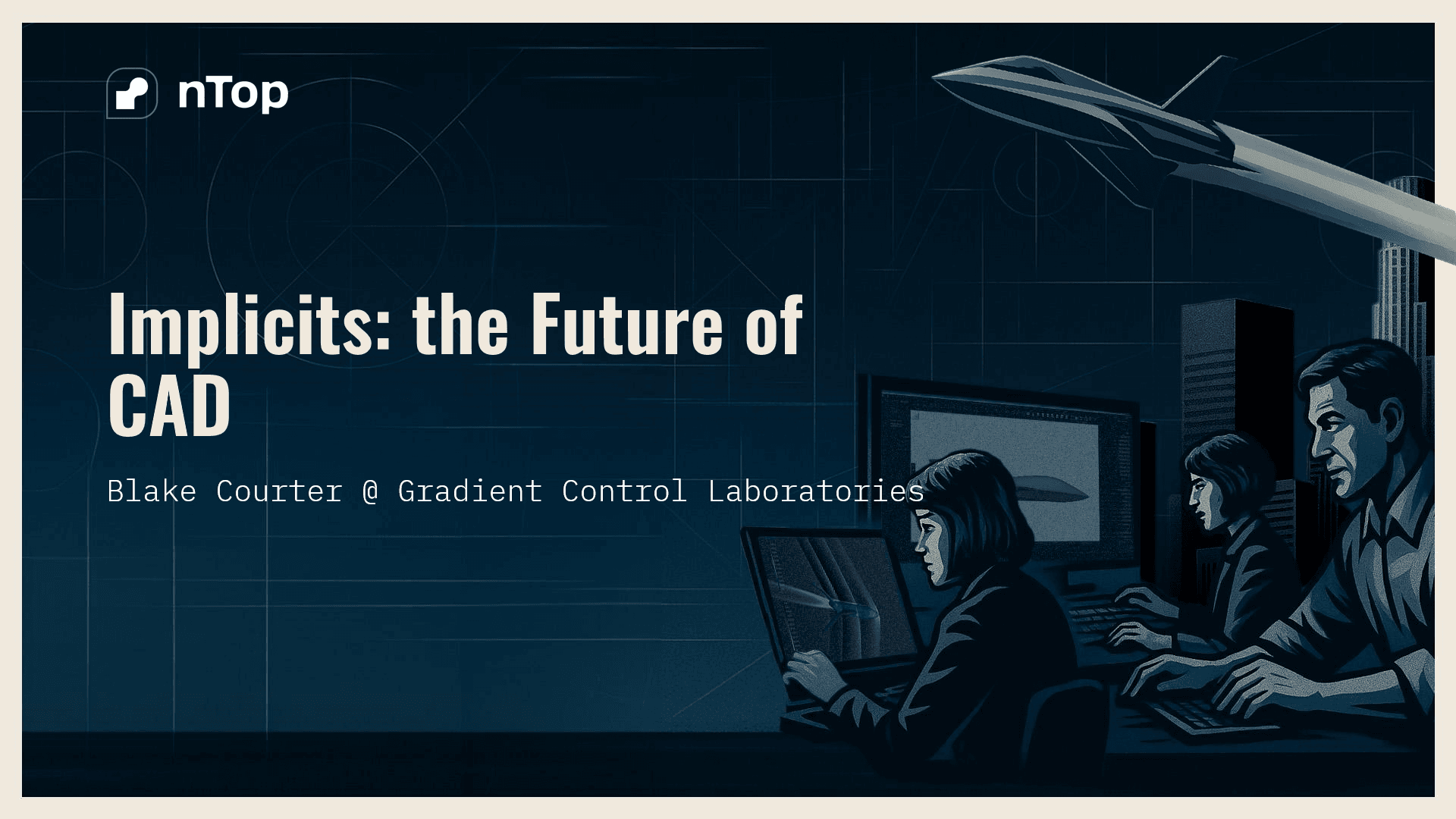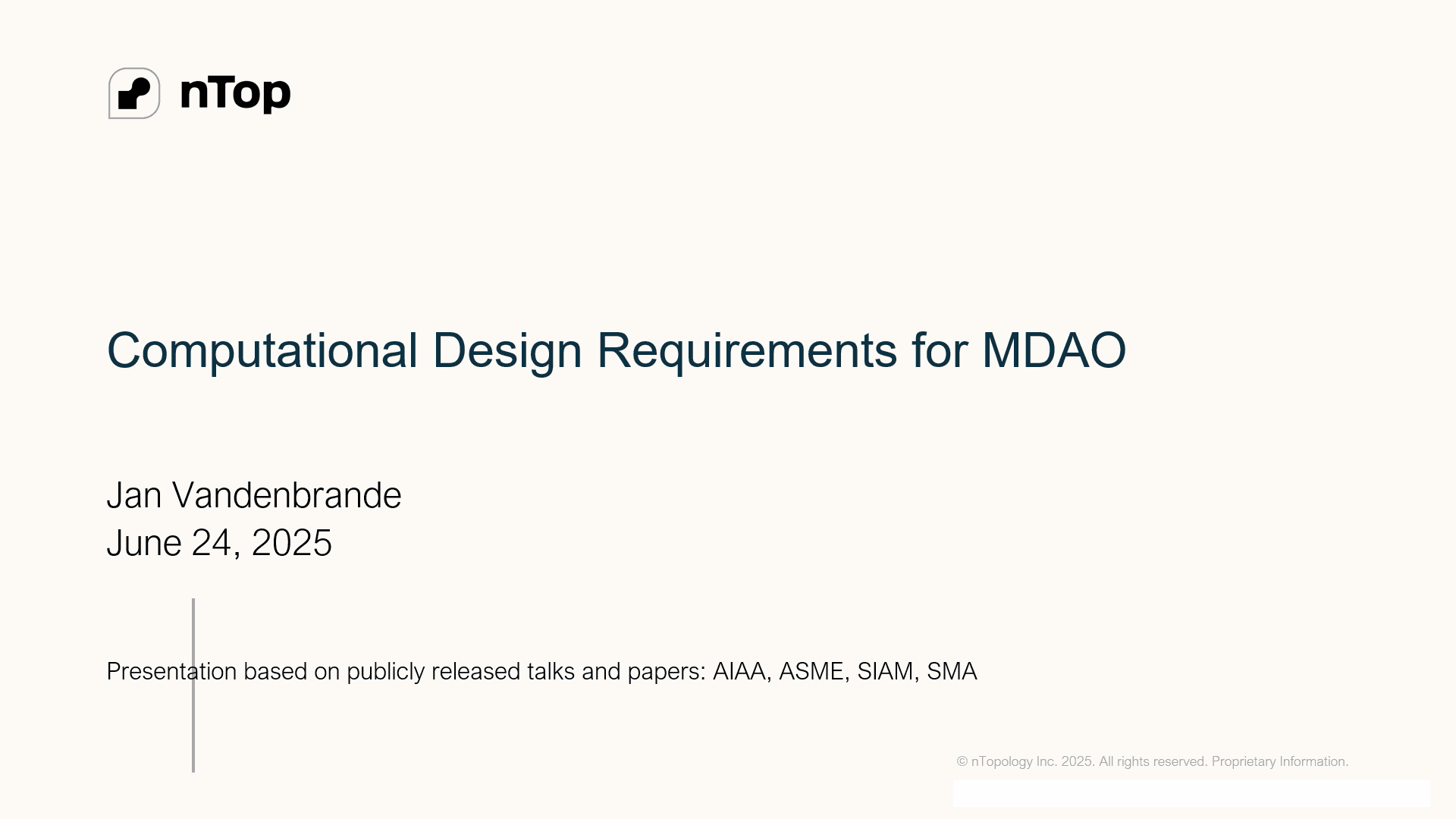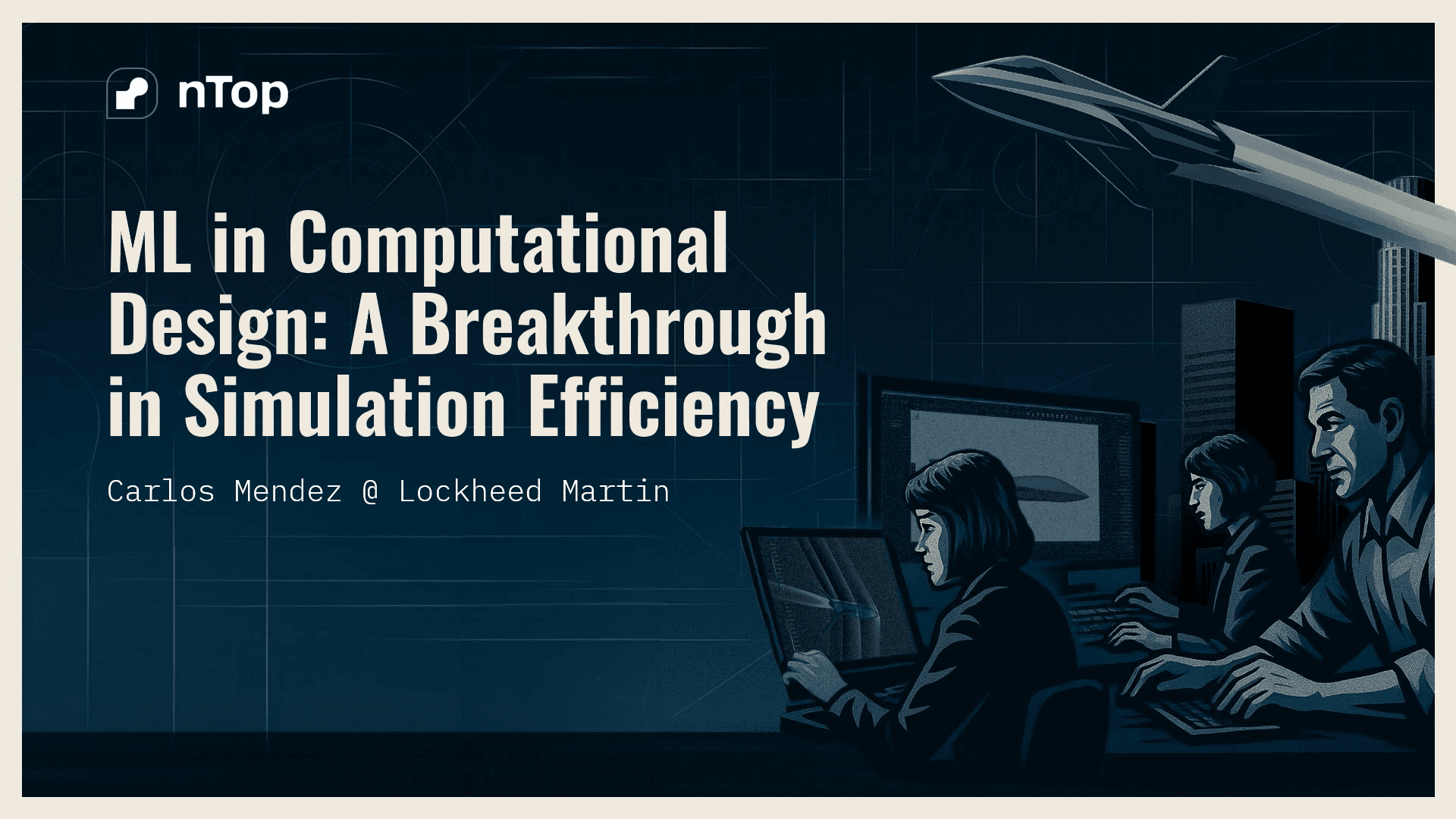Virginia Tech's DREAMS lab student projects

Written by nTop
Published on January 25, 2021
Virginia Tech’s “Additive Manufacturing” course of Fall 2020 featured a group of forty senior-level undergraduate and graduate students from across the College of Engineering. This class focused on AM technologies — the process physics and materials — and design for AM methodologies.
Due to COVID-19, Virginia Tech’s Additive Manufacturing class taught by DREAMS lab moved to a completely online/virtual experience this past Fall. To make the most of the situation, Dr. Chris Williams adjusted the syllabus to feature additional virtual visits from the AM industry. This included OEMs (such as ExOne, MELD, and SLM Solutions), AM service providers (like Big Metal Additive), and end-users (such as Boeing).
The virtual experience also provided an opportunity to provide students more hands-on time with software that excels in Design for Additive Manufacturing (DfAM) and associated training, which was something that was missing from prior course offerings.
This was where nTop and nTop Ed came in. nTop provided the opportunity to engage students with software that excels at DfAM operations that students have previously found challenging or impossible to implement with traditional CAD packages. nTop allowed students to learn about the power of lattices. The virtual training sessions led by nTop’s Application Engineer, Evan Pilz, gave them access to and knowledge of how to use advanced software to help them realize their concepts.
We reached out to students and asked them about their projects. Here are some of the final projects from the class that were created with nTop.
ERGO mouse: Shang Xu

Shang Xu is a Mechanical Engineering Graduate student slated to finish school this year. He is from Beijing, China.
What is the name of your project?
ERGO Mouse
What was your inspiration?
Dental cast + lattices + mouse case
Give us a brief description of your project.
Given the current global pandemic and rapid rise in remote work, most people spend even more time than normal in front of their computer. One of the greatest ergonomic concerns from this behavior is the pain and discomfort associated with a computer mouse’s long-term use. This is especially true when considering those with disabilities or long-term health concerns. Most mass-produced, commercially-available computer mice are designed to be cheap and easy to manufacture.
Unfortunately, low-cost mice are neither designed for ergonomics nor the comfort of the end-user. In some cases, those with disabilities are simply not able to use a traditional computer mouse.
By creating custom mouse shells, we can create a product that alleviates many of the health concerns and general pain caused by the long-term use of a computer mouse. Moreover, because we are only creating a shell for an already-existing mouse, it will allow us to focus more on the ergonomic aspects of the design instead of the functional components of the mouse.
The targeted users for this product are individuals with hand-related health ailments or disabilities, such as arthritis, carpal tunnel syndrome, or any individual with pain and discomfort from using a computer mouse. Therefore, this project’s design goal is to use a given non-ergonomic computer mouse and design a custom-fit mouse case for people with health ailments or disabilities.

What problem did nTop help you solve?
nTop helped me to design lattices in an intuitive way. The field-driven modifiers (especially the Ramp block) give a lot of design freedom. The block workflow UI is easy for team members to understand and learn. The Slice to B&W function enables easy printing for material jetting.
I could not have designed this project with another software — or it would have been extremely difficult.
What advantages did nTop provide?
Implicit bodies are interesting to work with and suit well for ergonomic designs where surface modeling is unnecessary. Very compatible with other software. 3D printing friendly can speed up prototyping.
What surprised you about nTop?
The block workflow is unique, just like coding. Changing variables and updating the design is very helpful.
Reusable rocket for STEM education: Nathan Kearney's team

Nathan Kearney is a senior in mechanical engineering from Raleigh, NC.
What is the name of your project?
Reusable Rocket for STEM Education
Give us a brief description of your project.
My team developed a 3D printed, reusable rocket that launched with a single impulse and then functioned as a glider. This rocket is an educational tool for students in the STEM field, and as such, we wanted to use 3D printing to provide an easily modifiable and quick to produce product. We also wanted to make sure that the cost was low enough so that experimentation and failure would not be a setback financially. As such, we wanted a cheap rocket body and cheap fuel.
We found that calcium carbide (which produces acetylene gas when reacting with water) was a cheap and stable fuel source that could potentially provide enough thrust to propel a lightweight vessel with some preliminary testing. Basic calculations show that the plastics used in desktop printers could withstand the heat of this combustion, so long as it was truly a short impulse and not a sustained burn, which this preliminary testing confirmed.
What problems did nTop help you solve?
The hardest part in the design was developing a body lightweight enough to be launched by this fuel. The chamber was a simple shell. However, the wings were bulky and could be dense.
Using the nTop, we made a lattice structure inside the wings, which provided strength comparable to what a standard infill pattern from a slicer could produce while significantly reducing the weight. To further reduce weight, we could reduce the lattice thickness as the distance from the body increased.
The result was a rocket that was 61g total, which includes the weight of the electronics required for ignition. After testing, the design seemed to work reasonably well; however, our application of the fuel and ignition location resulted in insufficient thrust required for liftoff.
nTop allowed for surprisingly easy modifications of the latticing and the ability to swap in new STL files without restarting the project, which was very useful in iterating through-hull and wing designs.

Bike helmet: Dominic LoPinto’s team

Dominic LoPinto is a 2nd-year graduate student completing dual Master's Degrees in Mechanical Engineering and Industrial and Systems Engineering. He is from Southampton, New Jersey.
What is the name of your project?
Bike Helmet
What was your inspiration?
One of our 5 fantastic teammates, Will Makowski, was critical in championing the effort we had seen as very impactful work. He mentioned: "from my professional experience in developing personal protective equipment (PPE), I had incorrectly assumed that those who were designing PPE were knowledgeable about the underlying problems about the products they were creating, were meant to solve. Our helmet team (Noah Haefner, Corbin Hawk, Joshua Hull, Dominic LoPinto, and Will Makowski) identified that for bike riders specifically, helmet fit is identified through interviews with the end-users, which is a barrier to safety in biking. So, to improve fit, our goal became to develop an impact-mitigating structure through additive manufacturing, using nTop as the first step to a more personalized fit."
Give us a brief description of your project.
Our project's main objective was to create a more personalized fitting and potentially more protective bicycle helmet with additive manufacturing, enabling a safer, more comfortable, lighter weight, and potentially more aesthetic helmet design.
We used a 3D Systems scanner and Fusion 360 to prepare a mesh for nTop, where the magic really started. We used conformal lattices and field-driven lattice thickening to consider impact structures through a new lens. In the end, we had refined our scope, given the limits of our timeframe, to be production of a few material lattices for impact testing and conformal designs for each of the tested lattices.

What problem did nTop help you solve?
I was the only one on the team with latticing experience. nTop provides a very low barrier to entry for everyone getting on board and exploring different lattice options. This knowledge gap was initially something we all had worried about.
Technically, nTop made the conformal latticing simple. Because of how fast nTop is, we did not have to choose just one lattice type. We could quickly iterate through many options and integrate a couple into the final considerations.
Could you have designed this project with other software?
I have developed lattices myself in the past. While generating a single conformal lattice would have been possible with specific traditional CAD tools, we could never have explored anywhere near as many design concepts as we had explored through nTop. Every new iteration would have to be remade or significantly tweaked from previous designs to get any sense of conforming to the scanned skull shape. Add in the field-based thickness gradient we implemented into the helmet, and creating this model in any reasonable timeframe is out of the question.
What advantages did nTop provide?
nTop essentially allowed us to code parameterized designs where the parameter was our unit cells and surface fields. This parametrization, combined with the minimal need for editing, provided a real advantage. We were going over different lattice designs and changing them in real-time in front of the team to make design decisions. Concepts that would normally be very difficult to communicate were suddenly as quick as a click.
Metal foam-based heat exchanger: Bharath Bharadwaj and Sudarasan Sadagopan


Bharath (left) and Sudharsan (right) are second-year graduate students in Masters in Mechanical Engineering and Engineering Mechanics respectively at Virginia Tech, Blacksburg.
What is the name of your project?
Metal foam-based heat exchanger for high-power processors.
Give us a brief description of your project.
With increasing demands on computational resources and the constantly increasing need for faster and powerful processors, the dissipation of excess heat generated in the electronics package becomes very important. Using liquid cooling with metal foams is an attractive alternative for thermal management problems.
Metal foams could help move the level of cooling used “one level down”. For example, in the CPU cooling, forced air cooling is becoming saturated. Instead of moving to liquid cooling, metal foams could provide satisfactory performance with forced air cooling. Similarly, two-phase applications could be reduced to single-phase liquid cooling, and so on.
Flow disturbances, local vorticity, and increased surface area are critical factors that contribute to better heat transfer performance in metal foams than conventional liquid-cooled mini channels.
For this course project, we designed three different metal lattice heat exchangers in nTop and selected the design for optimized performance. The prototype of the optimized design was printed. We hope to validate the experimental performance of the heat exchanger shortly.

What problem did nTop help you solve?
nTop helped design different metal lattices with ease during the concept generation phase and aided in selecting the best design to print. It is generally very challenging to model these complex lattices with other conventional CAD packages. The presence of a plethora of latticing options in nTop provided a quick way to check what could work for us.
Also, nTop is very useful in ensuring that the CAD file is ready for print in the right format with minimal errors. The very intuitive interface and the amazing UI in nTop, mostly the speed of geometry generation and meshing, some inbuilt analysis capabilities were surprising to see.
Most importantly, while both traditional CAD and analysis software require a lot of computational resources, we could use our normal laptops to get our designs with nTop.
Also, the other surprising aspect was the well-designed support page with not just ample resources to get started but also case studies that help appreciate the ability of nTop. It is amazing that nTop has an open culture of sharing valuable webinars and workshops of domain-specific applications case studies, which are very helpful from an application perspective to new students and seasoned industry experts alike in adopting nTop.
Looking to bring nTop into your classroom. Complete this nTop Education license request form.

nTop
nTop (formerly nTopology) was founded in 2015 with the belief that engineers’ ability to innovate shouldn’t be limited by their design software. Built on proprietary technologies that upend the constraints of traditional CAD software while integrating seamlessly into existing processes, nTop allows designers in every industry to create complex geometries, optimize instantaneously, and automate workflows to develop breakthrough parts and systems in record time.




